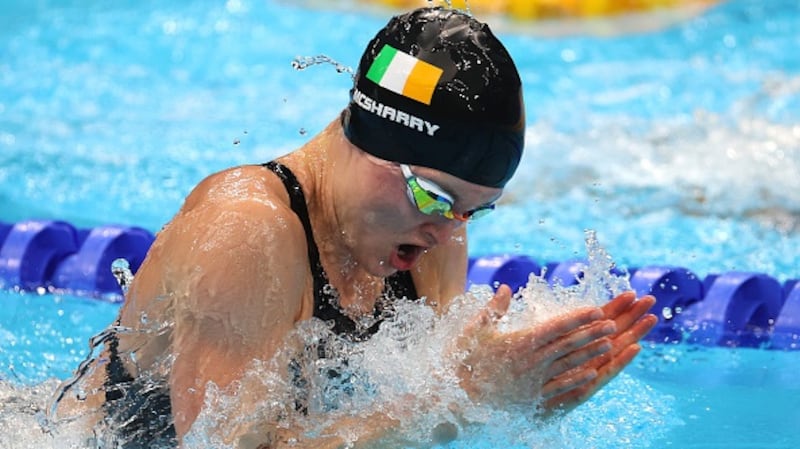A few weeks ago it appeared that Irish swimmer Ellen Walshe might be swimming in the freestyle event at the US National Collegiate Athletics Association (NCAA). The NCAA is the Big Cheese swimming event in college sport in the USA.
Both Dubliner Walsh and Mona McSharry from Sligo swam for Ireland at the Tokyo Olympic Games and are in swimming programmes in the University of Tennessee.
McSharry turned in a stunning performance to qualify for the 100m breaststroke final in Tokyo 2020, the first Irish swimmer to make an Olympic final for 25 years, while Walshe won the silver medal in the 400m individual medley at the World Short Course Championships last December. Both are exceptional athletes.
Because of ranking, however, it looks like Walshe will not swim in the 200 freestyle event against the University of Pennsylvania's transgender athlete, Lia Thomas, in the NCAAs that take place in March.
It is fair to say that because of the inclusion of Thomas in college swimming, athletes in the US are currently confused and deeply unhappy. Swimming is certainly divided over her presence.
It is also fair to say the most blameless person at the centre of it all, Thomas, is simply and correctly following the rules. But what’s taking place in the college pools of Georgia, Pennsylvania and Tennessee is what is coming down the line at higher levels of sport over the coming months and years.
As it was, the final night of the Ivy League Championships, which took place last weekend, featured a battle of transgender athletes for the title in the 100-yard freestyle. Ultimately, it was Penn’s Thomas, who touched first ahead of Yale’s Iszac Henig.
The problem facing swimming and other sports is how to get to a point where there is agreement that the playing field is level for all participants, that nobody feels disadvantaged
Thomas has transitioned to a female and Henig is in the process of transitioning from female to male but is allowed to compete as a woman because he has yet to take any testosterone. Thomas set six records at the championships.
She is a transgender woman in her first season as a member of Penn’s women’s team, following three years as an athlete on the men’s roster.
Number one
According to the highly respected US monthly magazine ‘Swimming World’ in the 200 freestyle, while Thomas “topped the college scene among women, her top time from the 2018-19 season ranked in the mid-500s among men.”
In fact she went from 554th male to number one female and is currently faster than Tokyo silver medalist, USA’s Alexandra Walsh. In the 200 freestyle her time of 1:41.93 beats Walsh at 1:42.28.
To be clear having transitioned to female more than a year earlier, Thomas was in compliance with the NCAA’s requirements for transgender participation. At the time, the NCAA required one year of hormone-suppressant therapy, which Thomas had undertaken.
Her emergence as a dominant force in swimming has, though, polarised opinion. In one group are those who can’t understand Thomas’ presence in women’s competition with the other group believing she should have access to inclusion and racing as she identifies.
The outcry against her participation in women’s sports has centred on a perceived unfairness faced by biological women, who in scholarship programmes are swimming not just for prestige but for their supper. Becoming a champion in sports across the board is particularly meaningful in American sporting culture.
Sporting context
As well as McSharry and Walshe, hundreds of Irish athletes across many sports have taken up US scholarships over the years, not least of all golf's Leona Maguire and runner Sonia O'Sullivan.

So, the issue in a sporting context is not only about inclusivity and fairness as there is an economic aspect. Athletes can lose their scholarships with injury or poor performances.
What ‘Swimming World’ believes is that Thomas does actually have an unfair advantage over other biological females in the elite end of competitive swimming. That point of view is based on their belief in the enduring effects of male puberty.
By transitioning to female after undergoing male puberty, it is argued that she acquired a number of permanent characteristics that give her certain advantages. In addition to possessing naturally higher testosterone levels, “Thomas’ experience with male puberty also offered enhanced lung capacity, larger hands and feet and greater strength.”
There are regulations now in place whereby transgender athletes must have reduced levels of testosterone. The US Swimming Association looks for a testosterone threshold of 5 nmols/L, although the NCAA is more generous and allows for twice the number, 10. A typical threshold for females is in the range of .5 to 2.4.
It’s a hugely sensitive area, so much so that those athletes who objected to Thomas taking part in swimming events wrote a letter to the university but would not put their names to it. Other swimmers came out and openly supported her participation on the basis of inclusion.
Some of those who have spoken out have been accused of being transgender phobia bigots and it’s likely that some are as is the case with abuse directed at many minority groups.
But the problem facing swimming and other sports is how to get to a point where there is agreement that the playing field is level for all participants, that nobody feels disadvantaged.
At the moment fear on both sides for different reasons and a polarising of opinion is preventing that from happening. Increasingly bitter and divisive, slow moving Governing bodies see a landscape fast changing.














